PAWPAW TALK & GLICKSTER VISIT
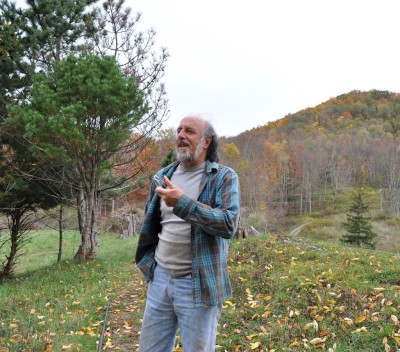 Deep in the hills of West Virginia, at the end of a steep, gravelly driveway, is where I found Glicksterus maximus. Sounds like a plant, doesn’t it? It’s not. It’s the self-ascribed nickname for Barry Glick of Sunshine Farm and Gardens (www.sunfarm.com), a mail-order nursery offering oodles of species and varieties of mostly herbaceous plants, many of them obscure and many of them native. I’d spoken with Barry, I’d planted his plants, and I’d sat on the receiving end of one of his entertaining and informative lectures, but I’d never visited his nursery/home. My own speaking engagement last week at the International Master Gardener’s Conference in Charleston, WV afforded me the opportunity for this visit.
Deep in the hills of West Virginia, at the end of a steep, gravelly driveway, is where I found Glicksterus maximus. Sounds like a plant, doesn’t it? It’s not. It’s the self-ascribed nickname for Barry Glick of Sunshine Farm and Gardens (www.sunfarm.com), a mail-order nursery offering oodles of species and varieties of mostly herbaceous plants, many of them obscure and many of them native. I’d spoken with Barry, I’d planted his plants, and I’d sat on the receiving end of one of his entertaining and informative lectures, but I’d never visited his nursery/home. My own speaking engagement last week at the International Master Gardener’s Conference in Charleston, WV afforded me the opportunity for this visit.Let’s cut right to the chase: Barry’s deepest affections go to one genus, Helleborus. And hellebores, as they are commonly called, were everywhere. (The plants are also called Christmas rose or Lenten rose although the blossoms do not really resemble roses and the plants do not necessarily bloom at Christmas or Lent.) Steep slopes beneath towering maples and oaks were blanketed with verdant carpets of thousands of hellebore plants. Many of these plants were seed plants for Barry’s breeding program. In addition to selling thousands of hellebores, Barry also has developed some new varieties.
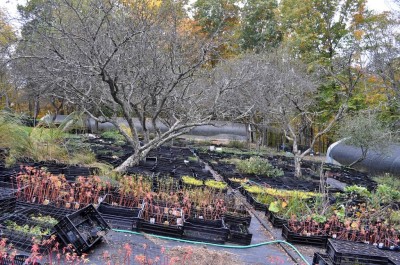 I had fun trying to identify some of the other plants tucked here and there all over the place, or lined out by the hundreds in pots. Ligularia was easily identified by its tall, straight, upright flower stalk even though its yellow flowers were long past. Rather than the familiar Ligularia ‘The Rocket’, Barry grows Ligularia sachalinensis. Fringetree (Chionanthus virginicus), a small tree whose branches burst with fringed, white blooms in spring, gracefully spread its branches; I brought home a small plant. As we walked up and down the hilly landscape past myriad plants, Barry called out their botanical names
I had fun trying to identify some of the other plants tucked here and there all over the place, or lined out by the hundreds in pots. Ligularia was easily identified by its tall, straight, upright flower stalk even though its yellow flowers were long past. Rather than the familiar Ligularia ‘The Rocket’, Barry grows Ligularia sachalinensis. Fringetree (Chionanthus virginicus), a small tree whose branches burst with fringed, white blooms in spring, gracefully spread its branches; I brought home a small plant. As we walked up and down the hilly landscape past myriad plants, Barry called out their botanical namesOne particularly attractive tree that I found impossible to identify was a mature sweetgum (Liquidambar styraciflua). Rather than sweetgum’s characteristic, five-pointed, star-shaped leaves, Barry’s tree, the variety ‘Rotundifolia’, had leaves with friendly-looking, rounded lobes. This variety is sterile, so also couldn’t be identified by the species rounded, spikey fruits commonly known by such names as “gumballs,” “burr balls”, “bommyknockers”, or “conkleberrys.”
——————————————-
We can’t just leave hellebores hanging a few paragraphs back. I also am a big fan of most of this genus, and am the proud grower, for 8 years now, of some of Barry’s creations. One asset of hellebores, mentioned previously, is their verdant foliage; I didn’t mention, though, that the leaves stay green all winter. This far north, I value anything green in our mostly achromatic winter landscape.
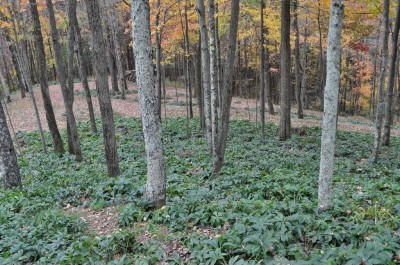 Another plus for this genus is that deer leave the plants alone. And that the plants thrive in partial shade. And that they self-sow to make new seedlings as well as spread vegetatively. They do so with enough restraint to never become a bother or, worse, invasive.
Another plus for this genus is that deer leave the plants alone. And that the plants thrive in partial shade. And that they self-sow to make new seedlings as well as spread vegetatively. They do so with enough restraint to never become a bother or, worse, invasive.While the flowers do not look like rose blossoms, they are beautiful, in colors from white to white suffused with purple to purple, and sometimes pale green.Wait, that’s not all! The flowers start blooming very early in spring, typically in March in my garden, and then continue to bloom for weeks and weeks.
———————————————
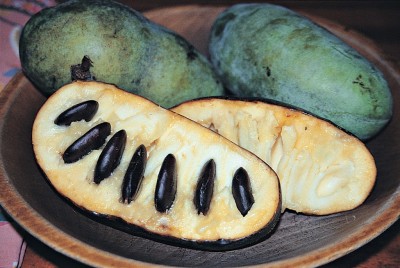 One of my lecture topics at the master gardener conference was “Landscaping with Fruit,” and one of the premier dual-purpose plants that I touted was pawpaw (Asimina triloba). The tree has a neat, pyramidal form and all season long sports large, lush, healthy green leaves that lend a tropical air to the landscape. It’s a tree that you can plant (plant two, for cross-pollination), give some care to get it growing, and then year after year harvest fruit without giving a second thought to pests or pruning. Even deer usually leave mature trees alone.
One of my lecture topics at the master gardener conference was “Landscaping with Fruit,” and one of the premier dual-purpose plants that I touted was pawpaw (Asimina triloba). The tree has a neat, pyramidal form and all season long sports large, lush, healthy green leaves that lend a tropical air to the landscape. It’s a tree that you can plant (plant two, for cross-pollination), give some care to get it growing, and then year after year harvest fruit without giving a second thought to pests or pruning. Even deer usually leave mature trees alone. 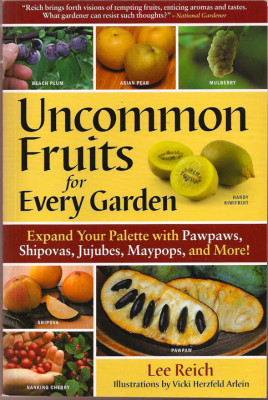 In addition to those lush leaves, pawpaw has other tropical aspirations. It is the northernmost member of the mostly tropical custard apple family. Each flower is a multiple ovary so can yield a cluster of up to nine fruits, similar to clusters of bananas except that pawpaws are shaped like and about the size of mangoes.
In addition to those lush leaves, pawpaw has other tropical aspirations. It is the northernmost member of the mostly tropical custard apple family. Each flower is a multiple ovary so can yield a cluster of up to nine fruits, similar to clusters of bananas except that pawpaws are shaped like and about the size of mangoes.Most tropical is the flesh itself of this cold-hardy, native fruit. Pawpaw flesh is creamy and yellow, like banana. What’s more, it has flavor that also is similar to banana along with some mango, pineapple, and avocado mixed in; or vanilla custard; or creme brulee.
Pawpaw trees shed their tropical aspirations in autumn, about now, when the leaves turn a clear, bright yellow and then drop. That’s also when the fruit ripens; I’m presently inundated with this easy-to-grow “tropical” fruit.
(I devote a whole chapter to pawpaw in my book Uncommon Fruits for Every Garden.)

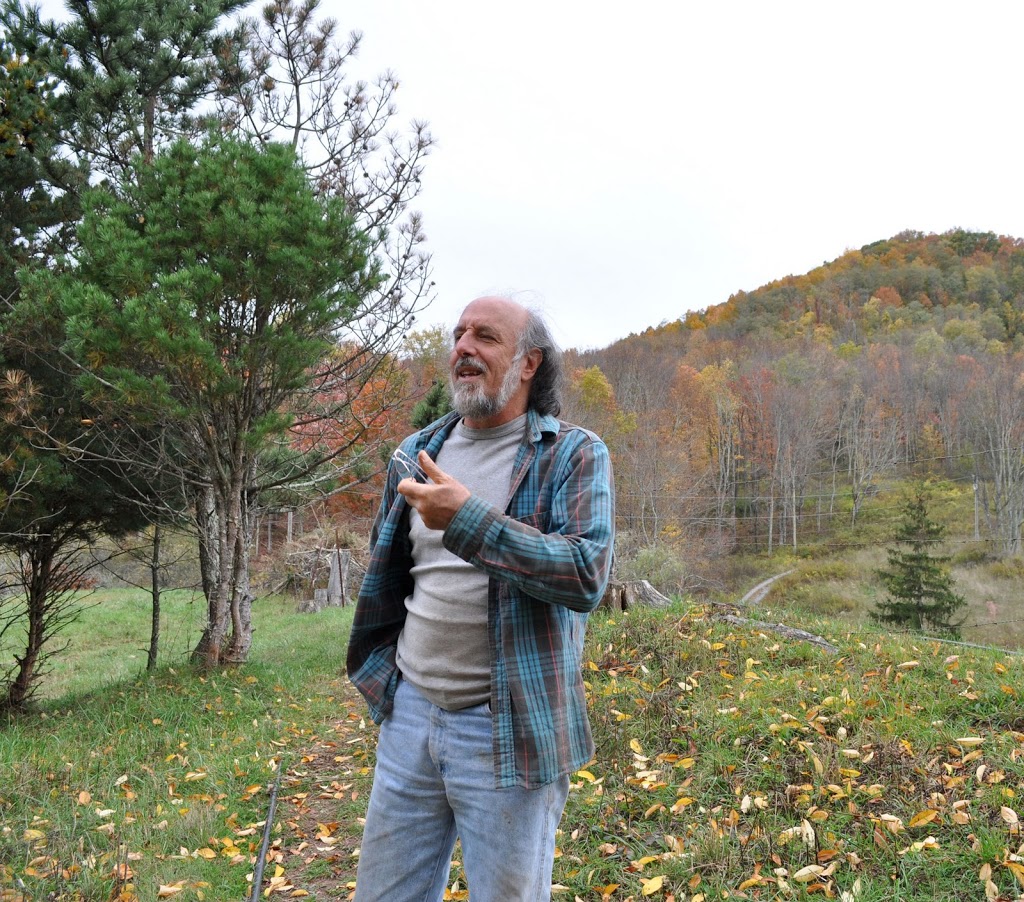



Hello
Is it possible to grow pawpaws in the new paltz area? I live 1 hour south of Albany and have been interested in growing them for a few years now. Also do you have any suggestions as to locating the fruit to taste in the area? Farmers markets perhaps? I am planning on ordering some fruit online as my curiosity has gotten the better of me 🙂
Thanks,
Mila
You definitely can grow pawpaws in the New Paltz area, and further north. I’ve grown and fruited them here in New Paltz for many, many years. Finding some to taste is more problematic. But . . . I may have a fall fruit workshop and tasting — with pawpaws and some other fruits — this year within the next few weeks. Let me know if you’d like to be on my email notification list for that workshop and other events.
That would be great! I have just found your website and am enjoying it very much and learnning a lot!
I’d love to get on your mailing list for pawpaw (and other!) workshops. Thanks.
Okay, you’re on it.
Just stumbled on this, replanted my apple orchard with several hundred Paw Paws last summer. Hope you are well and hope to see you again soon
Several hundred?!! Any plans for what to do with all the fruit?
Is there a paw paw farm or local fruits festival with paw paw fruit in the Newburgh area?
Not that I know of.
Been following your tips on so many fruit trees for years! I’m wondering though, what is your assessment of the data showing a strong association between annonaceae consumption and atypical Parkinsonism? The pawpaw has been specifically implicated in the literature, including a case study of a man who died after eating as many as 30 pounds per year, over the course of a decade. Do you feel this warrants at least some form of caution?
I don’t think the association is strong enough to have mentioned it, but it is surely worth further study. As for myself, it’s been a few years since I lost my taste for pawpaw and, when I learned of that association it put the cap on my eating them. I just not that hungry and have plenty of other good stuff to eat from my gardens.
With that said, further study should be done to establish cause and effect. One thing to consider is that the association has been not between pawpaw and disease but between a closely related tropical fruit. There also could be a dose response effect. Or a susceptibility of certain people or populations. These are just a few of the many variables. As I wrote, though, I’ve moved on to other fruits.
Hi Lee! Thanks so much for sharing your perspective. I agree about the need for more research. However, we can no longer say that there’s no association between pawpaw and atypical parkinsonism. Please consider the case study: “Progressive supranuclear palsy and pawpaw”. doi:10.1212/CPJ.0000000000000704 Thirty pounds a year, and now he is dead. Is it a randomized control trial? No. But it’s a noteworthy association, especially since we already know the mechanism of action. The sad thing is, he had a family-owned nursery. This is the sort of person who should have known what to look for. Lack of education may have cost him his life. If so, people should be warned, even as more research is done.
I got a copy of the article and will read and study it, and look for related information. Thanks.